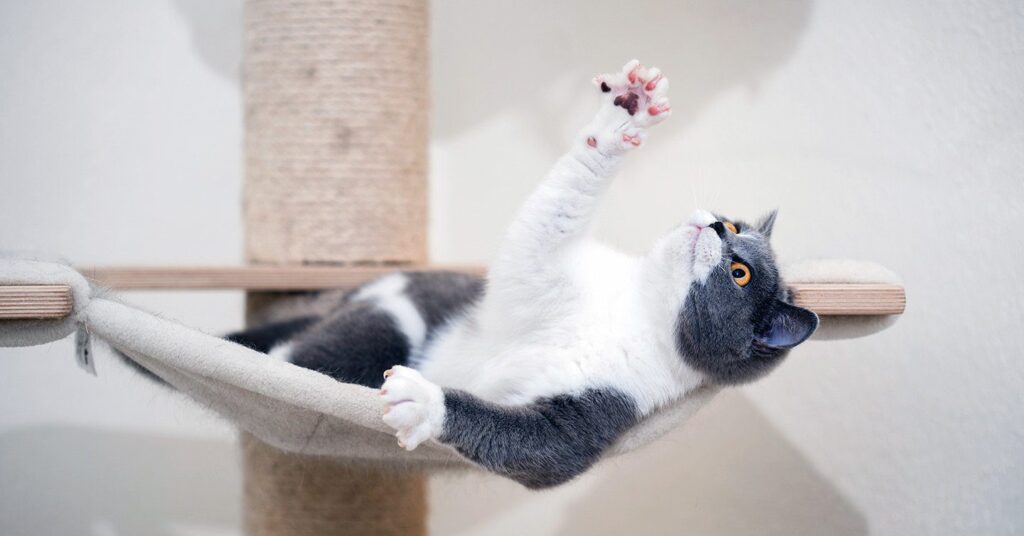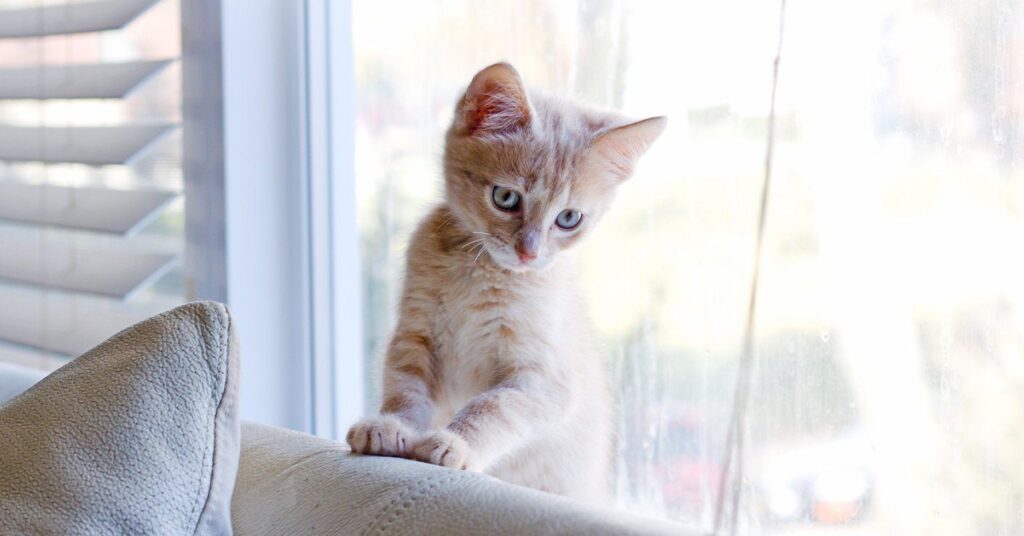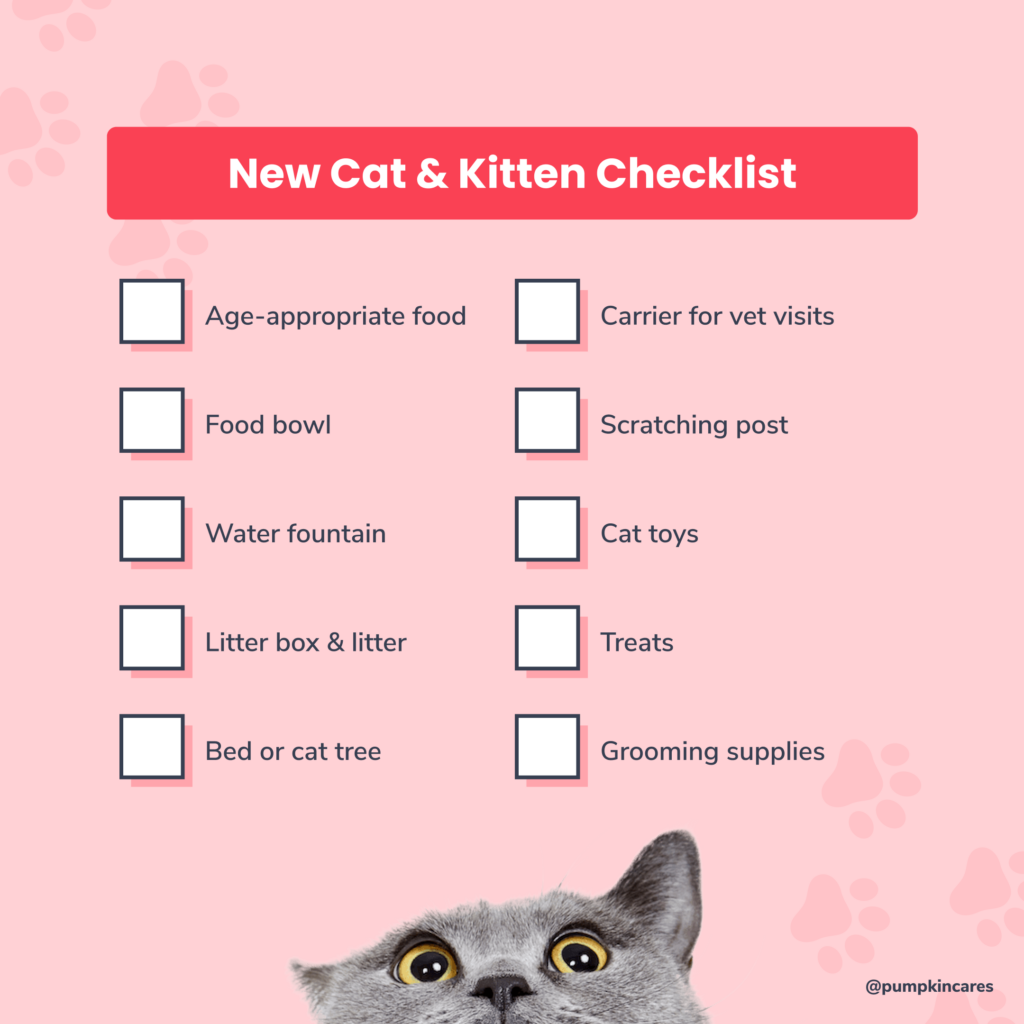You can’t wait to bring your new kitten home and show them all the love. But before your newest family member arrives, it’s time to kitten-proof the house, stock up on cat food, and find a vet. Your fur baby will need TLC, but they’ll also need nutritious food, a safe carrier, a litter box (or two), and plenty of toys. Expecting cat parents have a lot to think about, but don’t worry. Follow this new kitten checklist to prepare for life with your feline friend.
Cat food

Your little tiger needs healthy food to grow up strong. That’s especially true during the first six months of their life, when important development of bones, muscles, and the nervous system takes place.
Luckily, cat foods are labeled by age. When your cat is young, you’ll want to buy kitten food or food for all life stages. These have all the nutrients your little fluff ball needs when they’re still growing. You can also ask your vet about the best food for your kitten. Don’t forget to buy a food bowl, too.
Some people wonder if dry or wet food is better. But according to an AAHA study, both are equally healthy. The only time wet may be better is if your cat needs more water intake.
With all that yarn batting and acrobatics, your kitten is bound to get thirsty. Drinking plenty of water can help prevent feline diseases and keep your cat at a healthy weight. So make sure your kitty’s water bowl is always clean and full of fresh water.
Cat treats
Cat treats are just the thing when you need to keep your kitty happy at the vet, lure them into a grooming session, or train them to use the litter box.
Whichever treats you use, keep them small and don’t feed your kitten too many at once. (Your fur baby is still growing and can’t fit much in that tiny belly.) You may want to experiment to find out which treats your kitten likes best.
Litter box

One essential item on your new kitten checklist is a litter box. But what kind should you get?
It may be tempting to get a scented litter box, but most cats prefer them unscented. They also tend to like low-dust, clumping cat litter. Be sure to scoop your kitten’s litter box daily and change it completely once a week. It’s also a good idea to have two litters. You can usually train a kitten to use a closed or open litter box, so pick the one you prefer.
Training your kitten to use the litter box may be tricky at first, but most cats will learn pretty quickly. First, figure out where to put your litter boxes – and keep them there. If you move them, your kitten will get confused.
As soon as you get your kitten, put them in the litter box and let them sniff around. Over the next few days, place them in the litter immediately after meals and naps. You can also put them in the litter box if you notice them crouching or sniffing, which could be a sign that they need to go potty. Reward your kitten with a treat when they use the box, but don’t punish them when they don’t use it. Punishing your cat will only stress them out.
Before your kitten is fully trained, they may leave you a few surprises. That’s why it’s important to have pet-safe cleaning supplies on hand. Enzymatic cleaning products are the most effective for cleaning up cat urine.
Pet Pro Tip: New kitten owners often underestimate the long-term costs of veterinary care for a pet’s unexpected accidents & illnesses. Make sure you get your kitten insured as soon as possible!
Cat beds
Your kitten doesn’t absolutely need a bed, but they may enjoy having a comfortable napping spot. Consider getting a cat tree combined with a bed, as kitties love to look down on the world while they snooze. Just remember, the nicest, coziest cat bed is no guarantee your little bundle of fur won’t jump into your bed and curl up on your pillow.
Veterinary care

It’s important to take your new kitten to the vet for vaccinations and health check-ups. Your little fur bundle should visit a veterinarian at least once a year. It’s a good idea to choose a vet before your new kitten comes so you’ll be all prepared in case of an emergency.
Cat insurance
Speaking of emergencies, kittens are notorious for getting into scrapes. Cat insurance can help cover emergency care, medicine, and preventative checkups. The best time to get pet insurance is when your kitten is young and healthy – before they develop pre-existing conditions or hurt themselves attempting an acrobatic free fall from the countertop.
Home wellness checkups
To keep your kitten healthy and happy, you may want to do a quick weekly checkup at home. Check your kitten’s ears to make sure they’re clean and smelling fresh. Dirty, red, itchy, or bad smelling ears may be a sign of ear mites, which are especially common in kittens. Red eyes and noses can also be a sign that your kitty needs to see the vet.
Check that your kitty’s rear end is clean and free of worms. Feel for any lumps or scratches. And fluff up your kitten’s coat to check for flea dirt and parasites. On that note, you may want to buy some flea control to keep your fur baby comfortable.
Cat carriers

To transport your feline safely to and from the vet, you’ll need a comfortable cat carrier. Choose one with proper ventilation, inside padding, and an easy-to-open door.
If you want to travel with your cat, consider getting a leash and/or a cat backpack. Yes, you can train a cat to go for a walk. Instead of attaching the leash to your kitten’s collar, use a cat harness. It’s much more comfortable for your kitty and helps to prevent strangulation.
Cat collar
Don’t forget a collar and ID tag for your new pet. Even if your little tiger will be an indoor cat, it’s still important to keep an ID on in case they get loose. The American Humane Society suggests getting a “break-away” collar so your kitten can easily get free if their collar gets stuck on something.
As your little fluff ball grows, you’ll want to get a bigger collar for them. A collar that’s too small can be painful. Check the collar once a week until your adult cat is full grown. You should be able to fit two or three fingers between the collar and your cat’s neck. But make sure the collar isn’t so loose that it slips off your cat’s head.
Cat toys
If you’re like most cat parents, you can’t wait to get your little furball home for a good old-fashioned game of throw the ball or bat the mouse. Well, practice your throwing and tug-of-war skills, because kittens love to play. A basket of toys is essential if you want to keep your shoes, pillows, and yes, even toes, from becoming cat toys.
You may want to experiment to find out which toys your new friend prefers. Feathered toys are an all-time cat favorite, and so is anything with catnip inside. Some kitties also like toys with bells or squeakers. You can even get interactive toys to keep playtime going 24/7.
Scratching post

Your feline furball may be tiny and cute, but their claws can wreak huge havoc on your house. Cats scratch to release stress, sharpen their claws, and play. Invest in a cat condo or scratching post to keep your furniture from becoming kitty’s next victim. In fact, make that two scratching posts, just for good measure.
Grooming
Brushing your kitten regularly can help remove dead hair, promote healthy skin, and clear up tangles. Most kittens love being brushed, and you can make grooming time even sweeter with a treat or two. Short-haired kittens should only need one brushing session per week, but you may need to groom long-haired cats daily. Before brushing your kitten for the first time, let them sniff the brush. Start with short grooming sessions, and avoid doing sensitive areas until your cat is used to the routine.
Trimming your kitten’s nails can be a little trickier, but the good news is, most cats don’t need their nails trimmed. A scratching post should help keep your cat’s nails short, but if your kitten is still tearing up all the furniture, you may want to give those claws a trim.
Start to trim your kitten’s claws at four weeks old. Get cat nail clippers (different from human ones) and make the experience as low-stress as possible. Trim your kitten’s nails in a quiet, distraction-free environment. You may want to do it after a nap or a meal, when your kitty is relaxed. Use treats and a soothing voice to keep your kitty calm. Only cut off the white part of the claw.
How to brush your kitten’s teeth
To prevent dental disease, most vets recommend brushing your cat’s teeth twice a week. PetMD recommends that you start by massaging your cat’s lips, then move on to the teeth and gums. You might want to do this for a few weeks until your cat is comfortable with it. Then, put pet toothpaste on your finger and massage their teeth. Finally, you can move on to putting toothpaste on a toothbrush and letting your cat lick it. Once they’re used to this step, it’s time to start brushing.
What about baths? Most cats can go their whole lives without bathing. But if your little explorer runs through some mud or needs special treatment for a skin condition, they may need a quick bath. Keep the water lukewarm and dry your kitten off with a towel afterward.
Kitten-proof your home

An important step on the new kitten checklist is kitten-proofing your home. Electrical cords and cleaning supplies pose hazards for inquisitive little kittens, so keep those safely stowed away. Vertical window blinds and long cords present strangulation risks for cats, so it may be time to get some new curtains. Secure your window screens and keep kitchen and bathroom drawers shut. If you’re not already, get in the habit of closing all toilet lids so kitty isn’t tempted to go for a swim.
Kittens will scratch everything, so you may want to cover your furniture, at least until your cat gets a little older. Try using upside-down vinyl carpet runners, as cats don’t like the texture and will learn not to scratch it.
Give kitty time to adjust
Your kitten may need time to adjust to their new home, especially if you have other pets. Although we know you can’t wait to show off your little fur ball, you may want to avoid having guests over for the first few days.
Keep any other pets apart from your new kitten for the first few days, too. Let your old pets and your new cat roam the house separately to get used to each other’s smells. Then, after a few days, you can slowly introduce them to each other. Supervise the first few interactions just in case things get out of hand.
Of course, some kittens may love their new surroundings immediately, declare themselves king of the jungle, and demand head pats from complete strangers. But it’s best to play it safe.
Congrats on becoming a cat parent!

Toilet lids down? Furniture covered? Scratching post at the ready? Then it looks like you’re finally ready to welcome your new kitten! Follow these guidelines for feeding, grooming, and protecting your little felis catus, and you’re well on your way to becoming a responsible cat parent.





